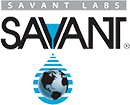Wear Preventive Characteristics
Author: Jeremy Coleman, Technician
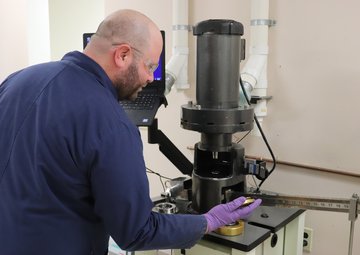 There are two four-ball tests that currently determine the tribological characteristics of a lubricating oil and a lubricating grease; the
four-ball extreme pressure (EP) tester and the four-ball wear tester. The
four-ball EP test covers the determination of the load-carrying properties of
lubricating fluids. The four-ball wear test covers the initial evaluation of
the anti-wear properties of fluid lubricants in sliding contact. In
addition, the SRV® test covers the extreme pressure properties of fluid lubricants
under high-frequency linear-oscillation motion.
There are two four-ball tests that currently determine the tribological characteristics of a lubricating oil and a lubricating grease; the
four-ball extreme pressure (EP) tester and the four-ball wear tester. The
four-ball EP test covers the determination of the load-carrying properties of
lubricating fluids. The four-ball wear test covers the initial evaluation of
the anti-wear properties of fluid lubricants in sliding contact. In
addition, the SRV® test covers the extreme pressure properties of fluid lubricants
under high-frequency linear-oscillation motion.
Extreme Pressure
Four-Ball
The test begins by first placing one steel ball under load against three steel balls held stationary in a nut assembly. The top ball rotates at 1760 r/min for 10 seconds. If the compensation scar is below the specified average scar diameter then the weights are increased until welding or incipient seizure occurs. If the compensation scar is above the specified average scar diameter, then the weights are decreased and 10-second runs are completed until the compensation scar is below the specified average scar diameter. Then the loads are gradually increased until the lubrication fails. This usually means that the lubricant film can no longer separate the surfaces, and this allows the two metal surfaces to come into contact.
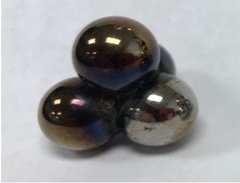 When the extreme pressure test fails,
this is called welding. There are certain attributes to look for. They
are: a sharp transverse movement of the friction force, an increased
noise level of motor, smoking from test-oil cup, a sudden drop in the
lever arm, or the motor comes to a complete stop, indicating the balls
have welded.
When the extreme pressure test fails,
this is called welding. There are certain attributes to look for. They
are: a sharp transverse movement of the friction force, an increased
noise level of motor, smoking from test-oil cup, a sudden drop in the
lever arm, or the motor comes to a complete stop, indicating the balls
have welded.
After the test has completed the last non-seizure load (LNSL), weld point (WELDPT), and load wear index (LWI) are reported. The last non-seizure load (LNSL) is the last load at which the measured scar diameter is not more than 5% above the compensation line at the load. Beyond this point, an incipient seizure occurs, indicating a momentary breakdown of the lubricating film. The weld point (WELDPT), is the lowest applied load in kilograms at which the rotating ball welds to the three stationary balls, indicating the extreme-pressure level to the lubricants force has been exceeded. The load wear index (LWI), is the load-carrying property of a lubricant. It is an index of the ability of a lubricant to minimize wear at applied loads.
Four-Ball Wear
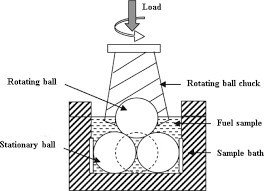
Lubricating oils and greases’ wear properties are determined using ASTM methods: D2266 for lubricating greases and D4172 for lubricating oils. The four-ball test method is used to make an initial assessment of the anti-wear properties of fluid lubricants in sliding contact. The four-ball test method shows how good a lubricant is at preventing wear, the more minute the wear scar the better the lubricant is at thwarting wear.
Unlike the extreme-pressure test, the four-ball wear test has set load, temperature, and rotational speed settings. The two procedures for D4172 both have the same temperature at 75 degrees Celsius and rotational speed at 1200 RPMs. Procedure A has a load per kilograms of force at 15 and Procedure B has a load per kilogram of force at 40. D2266 has the same temperature and speed parameters as D4172, but just has one load setting at 40 kilograms of force. All of the four-ball wear methods have the same time setting at 60 minutes.
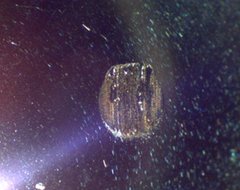 The four-ball test, just like the extreme pressure test, has three steel balls that are clamped together and covered with either a lubricant oil or a lubricating grease. A
fourth steel ball is then pressed into the steel balls with either a
force of 15 kilograms or 40 kilograms. The test is then run for 60
minutes and the wear scars are measured using a microscope and computer software. The average wear scars are reported, and lubricants are compared using these average wear scars. The 4-ball data is great for discerning between varying lubricants with different physical properties such as wear protection, load-bearing capabilities, and friction
reduction temperature and speed parameters as D4172, but just has one load setting at 40 kilograms of force. All of the four-ball wear methods have the same time setting at
60 minutes.
The four-ball test, just like the extreme pressure test, has three steel balls that are clamped together and covered with either a lubricant oil or a lubricating grease. A
fourth steel ball is then pressed into the steel balls with either a
force of 15 kilograms or 40 kilograms. The test is then run for 60
minutes and the wear scars are measured using a microscope and computer software. The average wear scars are reported, and lubricants are compared using these average wear scars. The 4-ball data is great for discerning between varying lubricants with different physical properties such as wear protection, load-bearing capabilities, and friction
reduction temperature and speed parameters as D4172, but just has one load setting at 40 kilograms of force. All of the four-ball wear methods have the same time setting at
60 minutes.
SRV® - Schwingung (Oscillating), Reibung (Friction), Verschleiž (Wear)
The SRV test is used to measure the extreme pressure properties of lubricating greases and lubricating fluid under high-frequency linear-oscillation motion. The SRV test is also used to determine a lubricating grease and lubricating fluid’s coefficient of friction and its aptitude to defend against wear when exposed to high-frequency,
linear-oscillation motion. The average wear scar dimensions on the ball and coefficient of friction are determined and conveyed.
There are several ASTM methods that are used for the SRV test machine:
Two of the more common methods are D5706 and D5707. D5706 uses a steel test ball oscillating against a stationary steel test disk with lubricant between them. The 100-N test load increments are increased until an incipient seizure occurs. The load, directly preceding the load at which seizure occurs, is measured and reported. D5707 examines a
lubricating grease or lubricating fluid, using a test ball that is oscillated under constant load against a test disk. The wear scar on the test ball and coefficient of friction are then measured.
The technical team at Savant Labs has a deep understanding of wear testing. We can help you define a test slate and analyze the data in a
concise and understandable format. Contact us for more information or request a quote for your next wear testing project.
